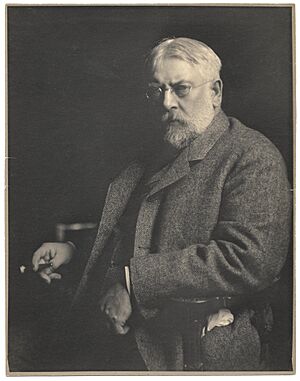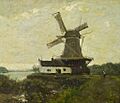Henry Ward Ranger facts for kids
Quick facts for kids
Henry Ward Ranger
|
|
|---|---|

Henry Ward Ranger, circa 1910
|
|
| Born | January 29, 1858 |
| Occupation | November 7, 1916 |
Henry Ward Ranger (born January 29, 1858 – died November 7, 1916) was an important American artist. He was born in western New York State. Ranger was famous for painting landscapes and scenes of the ocean (marine paintings). He was a key figure in an art style called Tonalism. He also led a group of artists known as the Old Lyme Art Colony.
Ranger became a member of the National Academy of Design in 1906. He also joined the American Water Color Society. Some of his well-known paintings include Top of the Hill and East River Idyll.
Contents
Henry Ranger's Early Life
Henry Ward Ranger was born on January 29, 1858, in New York State. His parents were Martha Marie and Ward Valencourt Ranger. He grew up in Syracuse. His father was a photographer and also taught drawing.
From a young age, Henry loved drawing and painting. His parents encouraged him. After high school, he studied art at Syracuse University for two years. He also helped in his father's photography business. During this time, he started painting watercolor landscapes. People were surprised by his free painting style.
In 1878, Ranger moved to New York City. There, he saw paintings from the Barbizon School for the first time. To pay for his art studies, he wrote reviews of music and theater for newspapers. In 1883, he married Helen Jennings.
Studying Art in Europe
Henry Ranger and his new family moved to Europe. They first visited Paris, France. Then, they settled in Laren, Holland. In Holland, Ranger joined a group of artists called the Hague School. He worked with famous Dutch painters like Jozef Israëls and Anton Mauve.
The Dutch artists quickly welcomed Ranger. He learned their painting style and subjects. He sketched with them and learned to paint the changing skies of Holland. Because Holland is very flat, the skies are a big part of the landscape. Ranger's early paintings often showed these cloudy skies with soft light.
Ranger enjoyed living in the quiet town. His artwork improved a lot. By the late 1880s, his paintings were accepted into the Paris Salons. Important Dutch art collectors also bought his work.
Returning to the United States
In 1888, Ranger opened an art studio in New York. He wanted to paint American landscapes. He also wanted to find American art collectors. In 1892, he had a big art show in New York. It featured twenty-four of his paintings. Critics gave the show good reviews.
His watercolor paintings were seen as lively and free. Ranger became a leader of the "Tonal" style of painting. He is even given credit for naming this style "Tonalism." An art show of his paintings in the mid-1890s made this style very popular.
In 1894, he had another show at the Macbeth Gallery. This gallery was the first to focus on American artists. Many paintings in this show were from a sketching trip Ranger took to Canada.
Founding the Old Lyme Art Colony
Henry Ranger was the first artist to join the Florence Griswold circle. This group formed the Old Lyme Art Colony in Old Lyme, Connecticut. He first stayed at Florence Griswold's boardinghouse in the summer of 1899. He may have heard about the area from other artists.
The landscape in Old Lyme reminded Ranger of the Barbizon forest in France. So, he helped start the art colony in 1900. Ranger led the group. The Old Lyme Art Colony became the largest art colony of its time.
Ranger taught artists to paint outdoors directly from nature. He also encouraged them to make their paintings interesting with texture. Then, like old master painters, Ranger and his followers added layers of golden-brown glazes. This gave their paintings a rich, soft look.
However, the Tonalism style in Old Lyme changed. In 1903, Childe Hassam joined the colony. With him, Impressionism became the main style there. In 1904, Ranger moved to Noank, about twenty miles east. He kept painting forests and coastal scenes. But his colors started to show the influence of Impressionism.
Henry Ranger's Artistic Legacy
After Henry Ranger died, his paintings continued to sell for good prices. In 1917, 129 of his paintings were sold for a lot of money. The New York Times said it was the highest average price for a dead artist's work.
Over time, Ranger's artistic reputation changed. He was once seen as the leader of the Tonal School. But in the 1930s, his fame went down. His work was influenced by other art movements. This made his Tonalist paintings seem old-fashioned to some.
Recently, people have started to appreciate Ranger's work again. He is now seen as an artist whose influence was not fully understood. His best landscapes show strong emotion. They have thick paint and rich colors. This shows the powerful forces of the natural world.
Henry Ranger was also a successful businessman. He left a large gift of money to the National Academy of Design. This gift allowed the National Collection, now the Smithsonian American Art Museum, to buy important works by American artists.
Gallery
See also
- Tonalism
- California Tonalism
- American Impressionism
- Pictorialism
- Barbizon school
- Paul Dougherty (artist)
- American Barbizon school







